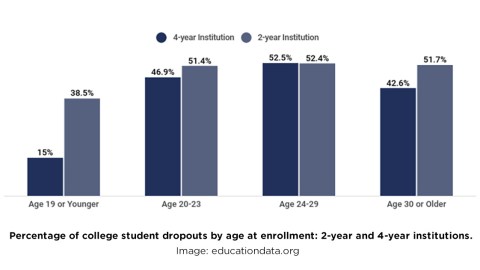American education: It’s colleges, not college students, that are failing

Image: educationdata.org
- COVID-19 has magnified the challenges that underserved communities face with regard to higher education, such as widening social inequality and sky-high tuition.
- At College Unbound, where I am president, we get to know students individually to understand what motivates them, so they can build a curriculum based on goals they want to achieve.
- My teaching mantra: Everything is permitted during COVID-19. Everything is permitted during COVID-19. Everything is permitted during COVID-19.
As a career educator, I’ve been called a radical all my life. I don’t really see myself that way, having worked for change from inside the public school system for 48 years. But I have ruffled feathers, and was even fired once, because when I see a school that needs help—and by extension, its students—my nature isn’t to sit idly by. That’s why Dr. Adam Bush and I started College Unbound, a degree-granting college for adult students who want their B.A. but are underserved by traditional colleges. COVID-19 has magnified the challenges that underserved communities face with regard to higher education: widening social inequality, tuition that puts students deep into debt, and a gap between what schools teach and what employers want.
85% of students from low-income families (the bottom quarter of earners) are statistically likely to drop out of college—a shockingly high number.
College Unbound has a so-called radical solution. Instead of telling students to choose a class from a predetermined list, we get to know students individually to understand what motivates them, so they can build a curriculum for themselves based on goals they want to achieve. One of our students, for example, after her baby got sick from drinking bad tap water, integrated a public awareness campaign about lead poisoning into her degree project. Another student focused on creating a data dashboard for a non-profit where she worked, moving her toward a degree while helping her employer. Another wanted to learn about a disease affecting her family, diving into medical and genealogical research with great passion.
We know students do best when they are deeply connected to what they’re learning. We also know that too many schools have a reputation for being boring. As a result, 85% of students from low-income families (the bottom quarter of earners) are statistically likely to drop out of college—a shockingly high number. But we largely accept that school will bore, and, incredibly, colleges say that students who leave weren’t “college ready” in the first place.
If 85% of students who would benefit most from earning a college degree are stopping out—a term with less stigma that I prefer to dropping out—it looks to me like colleges are the ones that aren’t “student ready”. At College Unbound, we prioritize being student ready. Students have class one night a week in small cohorts, which help form strong relationships. Teaching takes place in community buildings, like offices and schools not used at night, which is one of many ways we keep costs down. Our goal is to keep students’ out-of-pocket tuition expenses under $1,000 per year, so they can graduate with as little debt as possible. Our student-initiated academic model has even been called “the future of higher education” by the Association of American Colleges and Universities.
I have ruffled feathers, and was even fired once, because when I see a school that needs help—and by extension, its students—my nature isn’t to sit idly by.
Since COVID-19 forced a sudden shift to online learning, some teachers have expressed a passionate disliking for the educational dystopia they see before them. Others say, ‘We should all be online 100% of the time because who needs buildings, or in-person contact?’ These kinds of assumptions frighten me. Our focus should be on teaching effectively using online tools. To be honest, I’ve never loved online learning because I believe learning is so personal, and so much about doing, not just knowing. But I’ve accepted that online learning has a role to play. It allows busy adults to work when it’s best for them, without giving up their personal relationships with faculty, or their cohort, which are instrumental to success.
As we move into a new normal, I hope that some rules, which the virus has required educators to loosen, will stay loose, like the removal of SAT scores from college admissions applications. I also want to share my current personal mantra with teachers, who now face a great professional challenge. Everything is permitted during COVID-19. Everything is permitted during COVID-19. Everything is permitted during COVID-19. In-person teaching can’t simply be transferred online. So there is no better time than now, if necessary, to change up your approach to teaching, and to your students. The teaching methods we’ll rely on tomorrow will be born in the COVID trenches of today.





